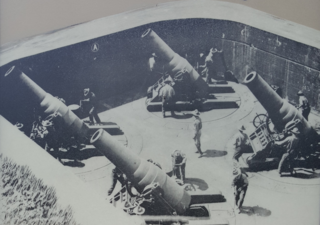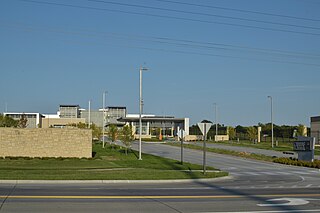Related Research Articles

Biological warfare, also known as germ warfare, is the use of biological toxins or infectious agents such as bacteria, viruses, insects, and fungi with the intent to kill, harm or incapacitate humans, animals or plants as an act of war. Biological weapons are living organisms or replicating entities. Entomological (insect) warfare is a subtype of biological warfare.

A biosafety level (BSL), or pathogen/protection level, is a set of biocontainment precautions required to isolate dangerous biological agents in an enclosed laboratory facility. The levels of containment range from the lowest biosafety level 1 (BSL-1) to the highest at level 4 (BSL-4). In the United States, the Centers for Disease Control and Prevention (CDC) have specified these levels. In the European Union, the same biosafety levels are defined in a directive. In Canada the four levels are known as Containment Levels. Facilities with these designations are also sometimes given as P1 through P4, as in the term P3 laboratory.

Fort Detrick is a United States Army Futures Command installation located in Frederick, Maryland. Historically, Fort Detrick was the center of the U.S. biological weapons program from 1943 to 1969. Since the discontinuation of that program, it has hosted most elements of the United States biological defense program.

The Agricultural Research Service (ARS) is the principal in-house research agency of the United States Department of Agriculture (USDA). ARS is one of four agencies in USDA's Research, Education and Economics mission area. ARS is charged with extending the nation's scientific knowledge and solving agricultural problems through its four national program areas: nutrition, food safety and quality; animal production and protection; natural resources and sustainable agricultural systems; and crop production and protection. ARS research focuses on solving problems affecting Americans every day. The ARS Headquarters is located in the Jamie L. Whitten Building on Independence Avenue in Washington, D.C. and the headquarters staff is located at the George Washington Carver Center (GWCC) in Beltsville, Maryland. For 2018, its budget was $1.2 billion.

Plum Island Animal Disease Center (PIADC) is a United States federal research facility dedicated to the study of foreign animal diseases of livestock. It is part of the Department of Homeland Security Directorate for Science and Technology, and operates as a partnership with the U.S. Department of Agriculture. The facility's director is Dr. Larry Barrett.

Plum Island is an island in the town of Southold in Suffolk County, New York. The island is situated in Gardiners Bay, east of Orient Point, off the eastern end of the North Fork coast of Long Island. It is about 3 miles (4.8 km) long and 1 mile (1.6 km) wide at its widest point.

Kanatzhan "Kanat" Alibekov, known as Kenneth "Ken" Alibek since 1992, is a Kazakh-American microbiologist, and biological warfare (BW) administrative management expert.

The United States Army Medical Research Institute of Infectious Diseases is the U.S Army's main institution and facility for defensive research into countermeasures against biological warfare. It is located on Fort Detrick, Maryland, near Washington, D.C. and is a subordinate lab of the U.S. Army Medical Research and Development Command (USAMRDC), headquartered on the same installation.

Fort Terry was a coastal fortification on Plum Island, a small island just off Orient Point, New York, United States. This strategic position afforded it a commanding view over the Atlantic entrance to the commercially vital Long Island Sound. It was established in 1897 and used intermittently through the end of World War II. In 1952, it became a military animal and biological warfare (BW) research facility, moving to civilian control in 1954 as the Plum Island Animal Disease Center. However, the biological warfare mission continued under civilian control until 1969, when the US ended offensive BW research. The island is now being considered for sale or conversion to a wildlife refuge. Fort Terry was listed on the National Register of Historic Places in 2021.

The One-Million-Liter Test Sphere—also known as the Test Sphere, the Horton Test Sphere, the Cloud Study Chamber, Building 527, and the “Eight Ball” —is a decommissioned biological warfare (BW) chamber and testing facility located on Fort Detrick, Maryland, USA. It was constructed and utilized by the U.S. Army Biological Warfare Laboratories as part of its BW research program from 1951 to 1969. It is the largest aerobiology chamber ever constructed and was placed on the National Register of Historic Places in 1977.
The United States biological weapons program officially began in spring 1943 on orders from U.S. President Franklin Roosevelt. Research continued following World War II as the U.S. built up a large stockpile of biological agents and weapons. Over the course of its 27-year history, the program weaponized and stockpiled the following seven bio-agents :
Erich Traub was a German veterinarian, scientist and virologist who specialized in foot-and-mouth disease, Rinderpest and Newcastle disease. Traub was a member of the National Socialist Motor Corps (NSKK), a Nazi motorist corps, from 1938 to 1942. He worked directly for Heinrich Himmler, head of the Schutzstaffel (SS), as the lab chief of the Nazis' leading bio-weapons facility on Riems Island.

The Soviet Union covertly operated the world's largest, longest, and most sophisticated biological weapons program, thereby violating its obligations as a party to the 1972 Biological Weapons Convention. The program began in the 1920s and lasted until at least September 1992 but has possibly been continued by Russia after that.

The National Bio and Agro-Defense Facility (NBAF) is a biosafety level 4 research laboratory in Manhattan, Kansas, operated by the United States Department of Agriculture. Slated to open in Summer 2022, the facility is designed to combat biological threats involving human, zoonotic, and foreign animal diseases. The NBAF will be replacing the aging Plum Island Animal Disease Center (PIADC) on Plum Island, New York. The primary research tenants of the facility will be the Agriculture Research Service (USDA-ARS) and Animal Plant Health Inspection Service, Veterinary Services (USDA-APHIS-VS). Construction on the 574,000-square-foot (53,300 m2) facility officially began in May 2015, and was scheduled to be completed by May 2021. The ongoing COVID-19 pandemic, however, has delayed scheduled commissioning to October 2021, followed by further delays to Spring, and, subsequently, Summer 2022. Operations will be fully transferred from the Plum Island facility by 2023. When fully operational, the facility will employ between 250 and 350 people. The facility is a constituent member of the Biosafety Level 4 Zoonotic Laboratory Network, and is currently led by Alfonso Clavijo.

The U.S. Army Biological Warfare Laboratories (USBWL) were a suite of research laboratories and pilot plant centers operating at Camp Detrick, Maryland, United States beginning in 1943 under the control of the U.S. Army Chemical Corps Research and Development Command. The USBWL undertook research and development into biocontainment, decontamination, gaseous sterilization, and agent production and purification for the U.S. offensive biological warfare program. The laboratories and their projects were discontinued in 1969.
The Vigo Ordnance Plant, also known as the Vigo Chemical Plant or simply Vigo Plant, was a United States Army facility built in 1942 to produce conventional weapons. In 1944 it was converted to produce biological agents for the U.S. bio-weapons program. The plant never produced any bio-weapons before the end of World War II but did produce 8000 pounds of an anthrax simulant. The plant was transferred to Pfizer after the war; the company operated it until announcing its closure in 2008.
The United States biological defense program—in recent years also called the National Biodefense Strategy—refers to the collective effort by all levels of government, along with private enterprise and other stakeholders, in the United States to carry out biodefense activities.
The National Veterinary Services Laboratories (NVSL) provides laboratory services for the US Department of Agriculture's Animal and Plant Health Inspection Service (APHIS). It operates from Ames, Iowa and Plum Island Animal Disease Center at Plum Island. The NVSL provides a wide variety of information and services, centered on diagnosis of domestic and foreign animal diseases, support of disease control and eradication programs, reagents for diagnostic testing, training, and laboratory certification.
Biological warfare (BW)—also known as bacteriological warfare, or germ warfare—has had a presence in popular culture for over 100 years. Public interest in it became intense during the Cold War, especially the 1960s and '70s, and continues unabated. This article comprises a list of popular culture works referencing BW or bioterrorism, but not those pertaining to natural, or unintentional, epidemics.
References
- 1 2 3 Cella, Alexandra. "An Overview of Plum Island: History, Research and Effects on Long Island", Long Island Historical Journal, Fall 2003/Spring 2004, Vol. 16, Nos. 1 and 2, pp. 176–181 (194–199 in PDF), accessed January 10, 2009.
- 1 2 3 4 Carroll, Michael C. Lab 257: The Disturbing Story of the Government's Secret Plum Island Germ Laboratory, (Google Books), HarperCollins, 2004, pp. 45–48, ( ISBN 0060011416).
- 1 2 3 4 Dunn, Adam. "The mysterious lab off New York's shore", CNN.com , April 2, 2004, accessed January 10, 2009.
- ↑ Wheelis, Mark, et al. Deadly Cultures: Biological Weapons Since 1945, (Google Books), Harvard University Press, 2006 p. 225-228, ( ISBN 0674016998).
- 1 2 Lambert, Bruce. "Closely Guarded Secrets: Some Islands You Can't Get to Visit", The New York Times , May 17, 1998, accessed January 10, 2009.
- 1 2 Telford, Sam (11 August 2019). "No, Lyme disease is not an escaped military bioweapon, despite what conspiracy theorists say". Washington Post. Retrieved 10 August 2020.
- ↑ Kirby, Reid. "Book Reviews Archived 2009-03-09 at the Wayback Machine ", Army Chemical Review, January–June 2005, accessed January 10, 2009.
- ↑ "Plum Island Animal Disease Center". Department of Homeland Security. 6 July 2009. Retrieved 10 August 2020.